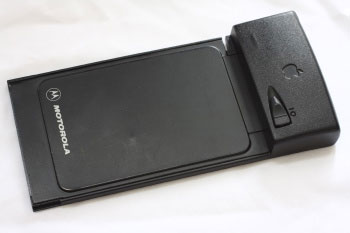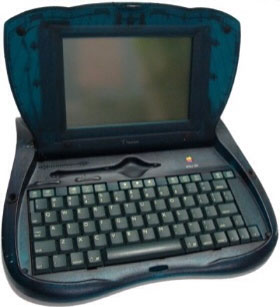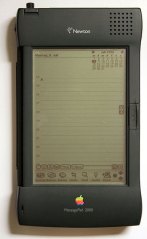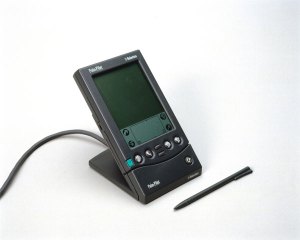Figuring out how to get additional software onto the MessagePad was no cakewalk. The Newton Connection Kit I’d bought reminded me how much computers have changed since the early-to-mid 1990s. The cable used a DB9 serial connector, an archaic standard long ago nudged aside by USB. As for the software, it came on a stack of 3.5″ floppy disks–which didn’t really matter, since it was a Windows 3.1 program which likely wouldn’t run on a 21st-century computer anyhow.
In theory, it should have been possible to hook it up to my 2012 MacBook Air using special software and an adapter that let the MessagePad’s serial jack connect to one of the MacBook’s USB ports. After failing repeatedly to get it to work for more than a half-second at a time, I gave up. And then I remembered that I had the Zenith laptop I used in the mid-1990s boxed up in my garage.
The Zenith had a serial port and a floppy drive, and it ran Windows 3.1. It worked fine with the Connection Kit. I ended up using my MacBook to download Newton apps — including a faux Tetris and an e-book of Alice in Wonderland — and then transferring them to the Zenith. Then I’d copy them to the MessagePad.

Peter Brockie
I had faint hopes of using my MessagePad and fax/modem for e-mail. It had come with a post card you could snail mail to Apple requesting a starter kit for the NewtonMail service; Apple apparently used the postcard as a means of buying some time, since NewtonMail wasn’t ready until months after the first MessagePads shipped. But NewtonMail is the only e-mail program that’s compatible with NewtonOS 1.0, and I assume that Apple discontinued it at some point in the past two decades. Even if it didn’t, it ran on Sprintnet, a dial-up network that’s no longer with us.
Unable to use my fax/modem to get online, I jotted a note on the MessagePad, then faxed it to myself. That worked perfectly.
A Newton Post-Mortem
Even by Newton standards, my original model, running 1.0 software, is a relic. Eventually, Newtons would enter the Internet age; clever people have even used later models to tweet and connect to wi-fi networks. And as Phil Baker explained to me, Apple was busy refining the MessagePad hardware and software even before the first MessagePad was sold.

Wikipedia
Like Bullwinkle repeatedly declaring that he’s about to pull a rabbit out of his hat–“this time for sure!”–the company kept releasing new Newtons which looked like they might be the model that would make the MessagePad a bona-fide success. There was the 110, the 120, the 130, the 2000 and the 2100, plus a fascinating proto-netbook called the eMate 300.
Newton hope tended to spring eternal. In March of 1994, the New York Times titled John Markoff’s story on the MessagePad 110 “Apple’s Newton Reborn: Will It Still the Critics?” A year and a half later, a Markoff piece on NewtonOS 2.0 was called “Apple’s Newton Poised for a Rebirth.” But neither the 110 nor OS 2.0 nor any of Apple’s other improvements did the trick.
Along the way, the Newton handwriting recognition got much, much better. That didn’t help enough–which may be a sign that consumers simply aren’t as interested in taking handwritten notes on an electronic device as Apple expected. After all, the only major post-Newton attempt to popularize handwritten input, Microsoft’s Tablet PC, also fizzled.
Even back in the 1990s, I remember becoming convinced that Apple was energetically pushing the Newton in the wrong direction. Sheer technological potency wasn’t the problem: Compared to the first model, the final Newton PDA, 1997’s MessagePad 2100, had fifteen times the clockspeed, 90 percent more pixels and more than twelve times as much RAM. It also had vastly better software.

Wikipedia
But the 2100 moved the Newton even deeper into tweener territory. It was taller, wider and thicker than the H1000, resulting in an even less pocketable gadget. It started at $1000; the H1000 had been $699. And it still didn’t come standard with the hardware and software you needed to exchange data with a PC.
Might Apple have served the Newton better by moving it in a different solution? We don’t have to treat that question as an imponderable. We just need to look at the case study provided by Jeff Hawkins’ Palm Computing.
After Palm’s big-time partners, Radio Shack and Casio, bailed on the Zoomer II, the company retrenched. With almost no resources, it got to work on a PDA that was far smaller, simpler and cheaper than the Zoomer. The new gadget used Graffiti instead of conventional handwriting recognition, and it came with a docking station and software that made syncing calendar and contacts with a PC a breeze.

Getty Images
Palm called its creation the…Taxi. But only briefly. When that moniker turned out to have trademark problems, the company changed the name to Pilot, shortly before the first units went on sale in 1996. Starting at just $299, the Palm Pilot became the phenomenon that the Newton was supposed to be but never was. It eventually evolved into the Treo, which was one of the two most significant pre-iPhone smartphones, along with the BlackBerry.
There was certainly some Newton in the Pilot. And there’s an awful lot of Pilot in the iPhone 4S, the iPad and every Android device–starting wtth the home screen’s grid of icons and the way apps run in full-screen mode. Had Apple followed Palm’s path–smaller, simpler, cheaper–it might have made all the difference.
Or maybe not. Newton fans took Steve Jobs’ 1998 decision to discontinue Apple’s PDA badly. They accused him of bearing a grudge against the gadget based on its origin as the brainchild of John Sculley, the man who had fired him in 1985. Perhaps so. But various other Apple executives had flirted with shuttering or selling Newton for years before the company’s co-founder returned. (Sculley was sacked by the Apple board just over two months after the first Newtons went on sale, in part because he was spending too much time being a visionary and not enough time selling Macintoshes.)
Another point to consider: Jobs didn’t seem to have any problem with plenty of other products and technologies which originated during the Sculley era, including PowerBooks, FireWire and QuickTime.
“The Newton achieved cult status, but the market was not big enough to see it become a success,” says ZDNet’s mobile-gadget guru James Kendrick, who owned an original MessagePad back in the day. “It was too expensive and big and clunky to become a mainstream hit. Jobs killed it out of necessity as the situation Apple was in when he returned was too bad to continue the expensive Newton line.”
Still, Kendrick sees hints of Sculley’s failed experiment in Jobs’ blockbuster gadgets. “I believe that Siri, introduced on the iPhone 4S, has a direct lineage with the Newton,” he told me. “The natural language interpretation was begun way back when on the Newton, as Apple tried to make the Newton work in a natural way.”
When Jobs decided to shut down the Newton division, color screens were still unaffordable, touch input was crude and wireless data didn’t get much more exciting than two-way paging. When he launched the first iPhone nine years later, technology allowed Apple to build the sort of devices it wanted to create in the 1990s, but couldn’t. He may have killed Newton, but he didn’t kill the dream behind it so much as press a giant pause button–and after finally spending quality time with a MessagePad, I’m more convinced than ever that he made the right call.
[MORE APPLE NOSTALGIA: Earlier this year, the Apple II turned 35.]


